Serviços Personalizados
Journal
Artigo
Indicadores
-
 Citado por SciELO
Citado por SciELO -
 Acessos
Acessos
Links relacionados
-
 Similares em
SciELO
Similares em
SciELO
Compartilhar
Observatorio (OBS*)
versão On-line ISSN 1646-5954
OBS* vol.8 no.1 Lisboa jan. 2014
The Internet as a source of information.
The social role of blogs and their reliability
Maria Keskenidou*, Argyris Kyridis**, Lina P. Valsamidou***,Alexandra-Helen Soulani****
*University of Western Macedonia, Greece
**Aristotle University of Thessaloniki, Greece
***Open University of Cyprus, Cyprus
****University of the Aegean, Greece
ABSTRACT
The current paper discusses the case of a social as well as technological phenomenon that has assumed great proportions in recent years, that of blogs. The purpose of this research is to explore students' views on: the role of blogs as a means of information, the reliability of blogs, and the social role of blogs. The selection of measuring students' views was made based on the fact that they form one of the most active social groups on one hand and that, on the other hand, they are considered to be some of the most frequent users of the internet. As an overall conclusion, the participants appear to have a positive attitude concerning blogs, whereas the research findings regarding the individual questions point out interesting views on behalf of the students.
Keywords: blogs, internet, information, social role, reliability, Greece
Introduction
The course towards Information Society has been long set and it is irreversible. Nowadays there has been an impressive development in computer networks which offers numerous possibilities of interactive communication and provides society with an easier access to the source of information. The World Wide Web as well as all the developments in communication technology contribute to the formation of virtual communities that consist of researchers, scientists and educators (Peraya, 1994). In the virtual space "one can dialog with kindred spirits having similar interests, skills and attitudes" (Loughlin, 1993). As he also pointed out in the same text, one could be isolated from one's peers in the real world while having "virtual friends that 'reside' just behind the screen regardless of the physical distances". Computer networks provide a social character to communication and social processes as they simulate face-to-face communication and create virtual spaces for many-to-many group discussions (Berge & Collins, 1995).
Almost all new media, such as blogs or the other kinds of online discourse (cf. Herring et al., 2007), have presented a notable rise in recent years (Chang & Yang, 2012: 1) that has resulted both from changes in the technological structure of mass media and also shifts in the social framework (Pleios, 2011:314). A blog (a portmanteau of the term web log) (cf. Hewitt, 2005) is a site or part of a site, whereas at the same time it constitutes a form of self-presentation on the internet (Griffith & Papacharissi, 2010). It is usually one person that keeps a blog with regular comments (or "posts"), description of events or other material in the form of graphics or videos that are usually displayed in reverse chronological order. The element that distinguishes most blogs from other static websites is interactivity: they allow visitors to leave comments or message each other via graphical user interface (GUI) devices on the blogs.
Blogs may display comments, the latest news on a certain field, or assume the role of a personal diary on the internet (cf. Kim 2005; Kaplan & Haenlein 2010). They are often public and may host – and they do – almost all contents, whereas they may be used for various purposes, like the other media (Pleios, 2011:327). Their presentation uses a combination of texts, images and links to other blogs, web pages and other media related to their topics. The primary element is the text, but there are also blogs that focus on art (art blogs), photographs (photoblogs), videos (video blogs or "vlogs"), music (MP3 blogs), and audio (podcasts). A type of blogging that uses very short posts is Microblogging, with Twitter as a characteristic example
More specifically, blogs consist of time-stamped texts, images, objects and data, organized in reverse chronological order that use HTML-based markup (de Moor & Efimova, 2004; Herring et al. 2005), or more simply, blogs are frequently updated sites with posts displayed in reverse chronological order (Herring et al. 2004; Tremayne, 2007). One might suggest that blogs are "entry-oriented" – an entry being the basic unit – and not "page-oriented" as with more traditional Web sites (Gumbrecht, 2004).
However, a fundamental point in the discussion about blogs is the fact that on one hand they are a product of technology (Web 2.0) and on the other they are the result of a long and often conflictual process of expanding and democratizing mass communication (Pleios, 2011:315). From the point of view of usage, a focal element in the original blog are the connections of the public sphere as it was presented by Habermas ([1962]1989). The functions of the blogs, which offer the ability to argue about the formation of the blogosphere as a new public sphere that expands the existing one (about the expansion cf. Pleios, 2011: 327) , are as follows:
- The ability to comment on each entry usually by anyone, which allows the interaction between bloggers and the development of bonds between the readers and the entry authors. The comments in blogs provide added value as they enrich the discussion that is taking place.
- The fact that each entry has a unique URL (permalink) to which anyone can address focusing on the content of a specific idea and not its creator that is to the blog in its entirety.
- The possibility to locate references and therefore the discussions created by a specific entry by the author (trackbacks) (Kaye, 2007).
Blogs supply authors with a personal communication space that has direct access to the public space. As a result, a blogger can participate in two kinds of dialogue at every given moment: a dialogue with one's self and a dialogue with the others (Efimova, 2004).
A blog may significantly influence the social landscape and have a social role. It is along these lines that Tremayne (2007) maintains that a blog may arise as the voice of the citizens; especially in cases of social turmoil, such as the recent unrest in the Middle East (cf. Cottle, 2011 ; Ghannam, 2011; Sekeris & Chenavaz, 2012),blogs replaced the Mass Media and spontaneously reported news as they took place.
It has been supported, however, that blogs are the absolute interpretation of freedom of speech and democracy but without any control as to the quality (cf. Turban et al, 2010). In many cases, anonymity and lack of firm evidence may transform a blog from an information tool into an instrument of spreading false news and rumors.
Research objectives – research questions
The current paper discusses the case of a social as well as technological phenomenon that has assumed great proportions in recent years, that of blogs. The purpose of this research is to explore students' views on: a) the role of blogs as a means of information, b) the reliability of blogs and c) the social role of blogs.
The selection of measuring students' views was made based on the fact that they form one of the most active social groups on one hand and that, on the other hand, they are considered to be some of the most frequent users of the internet.
Methodology – Sample
The research was conducted in March 2011. The sample comprised 158 undergraduate and graduate students coming from higher educational institutions around Greece – more specifically 3 different university departments: the department of Balkan Studies at Florina, the department of Economics and that of Applied Informatics at the University of Macedonia. It is obvious that the size and the kind of the sample does not allow a projection to either a more total population size or a population of more general characteristics.
The sample consisted of students that were selected (a) due to their young age and (b) because the ability of typical abstract thought has already set on since the age of 12-13 (Piaget, 1970), the systematic process of the critical evaluation of the provided knowledge is the typical quality and the fundamental challenge for the young adults that study in universities. More specifically, numerous studies (Hagedorn et al., 1999; Pascarella, 1989; Tan, 1995) found out that young adults with university training had more opportunities to develop critical thinking and the relative skills that foster lifelong learning compared to other adults with no university background. Furthermore, another research (Flowers et al., 2001) claimed that even in their first year of university studies students present significant cognitive and learning benefits. According to the theories of leading developmental psychologists (Baxter-Magolda, 2006; King & Kitchener, 1994; Perry, 1970; West, 2004) who studied cognitive development in early adulthood, it was found that university attendance allows the transition from the simplistic and absolute certainty of knowledge acquisition to complex and sophisticated probabilistic systems of assessing it. Despite their individual differences, all these cognitive-developmental approaches point out that the reflective approach to knowledge helps defining its nature and limitations, whereas it sets the ground for the intellectual engagement with modern complex problems (Baxter-Magolda, 2004; King & Kitchener, 2004). More specifically, students begin to abandon the binary model of problem solving ("right" – "wrong") in favour of a "multiple" probabilistic approach. Thus, they form the circumstances under which critical thinking is facilitated aiming at an effort to interpret modern socio-cultural conditions and also a fundamental need of dealing with hypothetical, ideological problems (Thomson, 1999).
The methodology that was followed was that of a questionnaire with closed and open questions, 62 in total. Content analysis was used for the purpose of analyzing the answers in open questions. The questionnaire that was distributed and answered in written consisted of the following categories of questions:
A) questions pertaining to personal and demographic characteristics which were: gender, institution of attendance (Higher Institution of Education or Higher Technological Institution of Education), level of studies (undergraduate or graduate), age (18-22 years or 23+), employment, field of studies (social sciences, humanities or applied sciences), degree of urbanity (Athens/Thessaloniki, capital of prefecture, semi-urban or rural area), maternal and paternal occupation (freelance scientific occupations, public employees, tradespersons, workers, farmers and housewives for mothers) maternal and paternal level of education (illiterate, primary school graduate, high school graduate, Technological Institute graduate, University graduate or Master's holder).
B) 5 closed, multiple choice questions, regarding students' knowledge on computers, frequency and manner of use.
C) A scale of 62 statements (Cronbachs alpha = 0.805), consisted by three sub – scales (1st sub – scale: Blogs as sources of information, 18 statements [Cronbachs alpha = 0.789], 2nd sub – scale: The social role of the blogs, 24 statements [Cronbachs alpha = 0.712] and 3rd sub – scale: The reliability of the blogs, 20 statements [Cronbachs alpha = 0.707]. The level of the agreements to these statements is expressed by the using of a 5-grade Lickert scale (1=strongly disagree, 2= disagree, 3= neutral, 4= agree, 5= strongly agree).
The questionnaire ended with an open question (part D) which was answered by 80 students out of the total number in the research: "Blogs as a source of information and their reliability". The question consisted of two parts, those of information and reliability, whereas content analysis was performed on the answers with the following 5 categories of answers in the first part:
1. Source of information of the future
2. Blogs are a means of update on various issues
3. I don't know
4. Blogs are the same source of information as the Mass Media
5. Blogs are an alternative source of information that could replace the Mass Media.
In the second part, that of reliability, content analysis was performed on the answers with the following categories of answers:
1. Reliability depends on other factors
2. Blogs are a valid source of information
3. I don't know
4. Blogs are not always a valid source of information
Results
The indicator of internal validity of the tool demonstrated that Cronbach's a on the total of the questionnaire was 0,785, whereas on the three categories of the 5-point Lickert scale questions Cronbach's alpha was 0,772. Once the answers were processed by the Statistical Package for the Social sciences (SPSS), the following results were obtained.
Regarding the students' demographic data
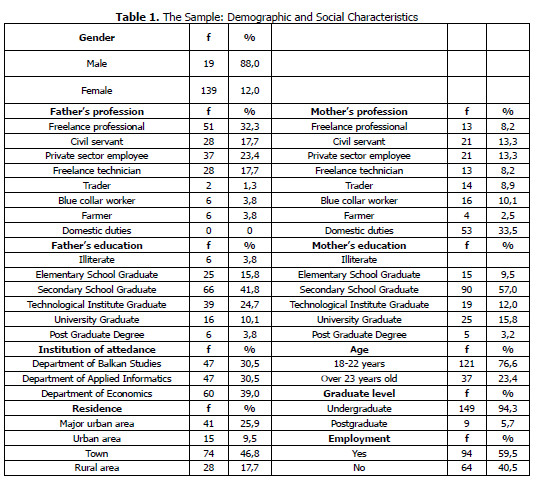
Gender
Out of the students that were asked, 139 were females (88%) and 19 were males (12%).
Institution of attendance
Of the 3 university departments that participated in the research, 47 students came from the department of Balkan Studies (29,7%), 47 students were of the department of Applied Informatics (29,7%) and 60 students came from the department of Economics (38%). Also, 4 students (2,5%) neglected to fill in their institution of attendance.
Level of studies
149 of the students were undergraduate (94,3%) and the remaining 9 (5,7%) attended a graduate course.
Age
Where the age factor of the participating students is concerned, it ranges from 18-22 years of age and over 23 years old. More specifically, there were 121 individuals (76,6%) between the ages of 18-22 and 37 individuals were 23 or over (23,4%).
Employment
94 of the students that took part in the research were employed (59,5%) whereas 64 of them were unemployed (40,5%).
Degree of urbanity
As to the urbanity of the students that comprised our sample, 25,9% came from Athens or Thessaloniki, 9,5% came from the capital of a prefecture, 46,8% were of a semi-rural area and 17,7% came from a rural area.
Paternal occupation
Regarding the occupation of the students' fathers in the sample, 32,3% are in freelance scientific professions, 17,7% are employees in the public sector, 23,4% are in the private sector, 17,7% are freelance technical professionals, 1,3% are tradespersons, 3,8% are workers and 3,8% are farmers.
Maternal occupation
Regarding the occupation of the students' mothers in the research sample, 8,4% are freelance scientific professionals, 13,5% are employed in the public sector, another 13,5% are in the private sector, 8,4% are freelance technical professionals, 9% are in trading, 10,3% are workers, 2,6% are farmers and the remaining 34,2% are evidently unemployed housewives.
Paternal education
In relation to the education of the students' fathers in the research sample, 3,8% are illiterate, 15,8% are primary school graduates, 41,8% are high school graduates, 24,7% have graduated from a higher technological institution, 10,1% are university graduates and 3,8% hold a graduate diploma.
Maternal education
In relation to the education of the students' mothers in the research sample, 15 individuals (9,7%) are primary school graduates, 90 individuals (58,4%) are high school graduates, 19 (12,3%) have graduated from a higher technological institution, 25 individuals (16,2%) are university graduates and 5 individuals (3,2%) hold a graduate diploma.
As to the students' answers to the individual research questions
Computer use

In relation to where young people usually use the computer, 138 students of the sample (a percentage of 87,3%) replied at home, 28 students (17,7%) answered at a friend's home, 5 students (3,2%) said at school, 4 students (2,5%) said at an internet café and 22 students (13,9%) replied elsewhere (e.g. at work).

Regarding how many times a week young people usually use the computer, 116 students of the sample replied every day (a percentage of 73,4%), 23 students at a percentage of 14,6% answered several times a week and 23 students (14,6%) said rarely.
The majority of the sample, that is 134 students spend 2-30 hours in front of the computer and a percentage of 15,2% spend 5 hours a week.
How many hours do you spend at the computer per week

What do you like most doing on your computer?
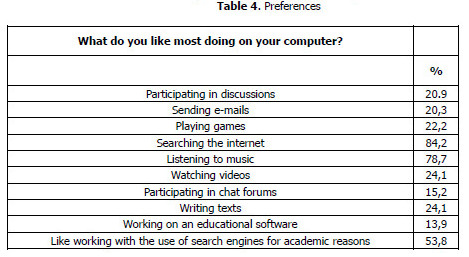
Regarding the students' knowledge in the field of technology and computers, only 3 answered "none", 10 replied "some", 81 students answered "average", 54 students answered "a lot" and 10 replied that they have a very good knowledge of computer use.
The results of the scale and the sub – scales
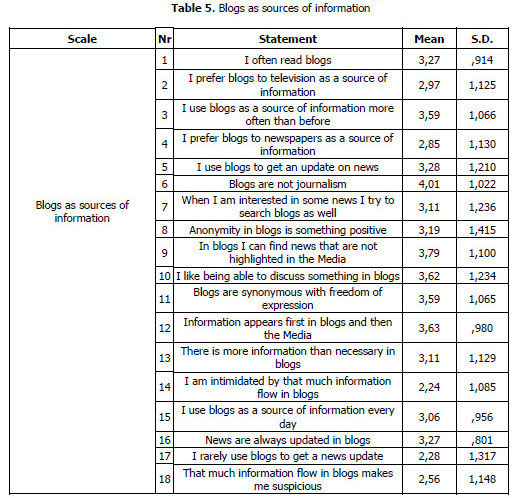
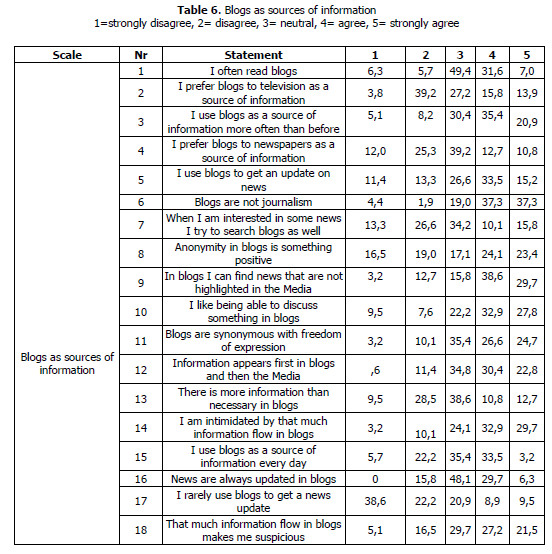
Of particular interest is the Mean value (4,01) in the statement "Blogs are not journalism", which indicates that the individuals who responded think lesser of blogs as journalism tools. An outstanding 74,6% disagrees with this particular statement, while only 6,3% agree. However, the subjects' responses to statements 2, 14, 15 and 18 in combination with the answers to statements 3, 5, 8, 9, 10, 11, 12 and 16 demonstrate that despite the fact that blogs have not yet earned an equally significant position as the other media in young people's information (apparently they have not gained the dynamics of traditional media), it seems that the disputed objectivity and independence of the latter together with the more prominent social nature of blogs have accredited increasing social dynamics to blogs.
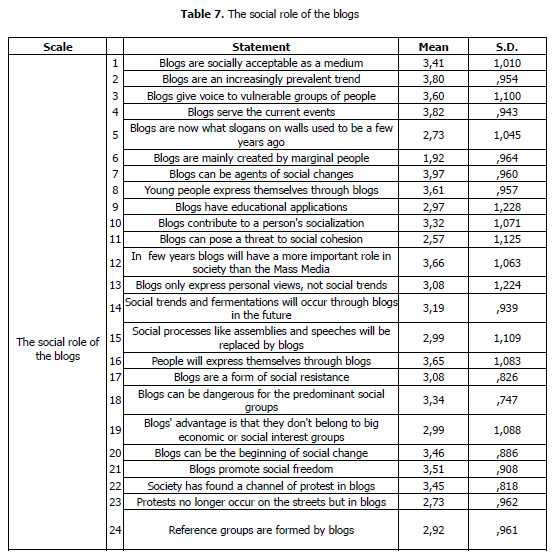
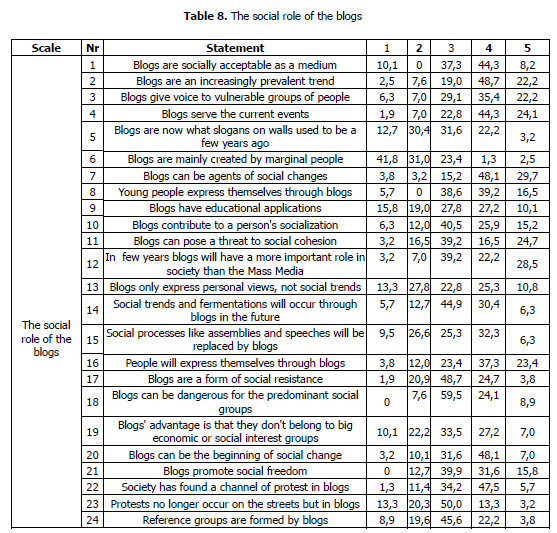
The students' answers reveal that the social role of blogs has not only been reinforced, but it also has gained strong dynamics at the same time. The events in Egypt and Algeria as well as the vigorous protests in Athens and Spain in 2011 have accentuated the revolutionary dynamics of blogs, a fact that is displayed in statements 3, 4, 6, 7, 8 and 14 – 22. (cf. Cottle, 2011; Ghannam, 2011; Sekeris & Chenavaz, 2012). The students' responses appear to be in alignment with recent studies that demomstrate the upward trend and the dynamics of blogs both in relation with the increased number of users and the possibilities of expressing and questioning the current status quo (cf. Frangonikopoulos & Chapsos, 2012:12; Radsch, 2011: 73)
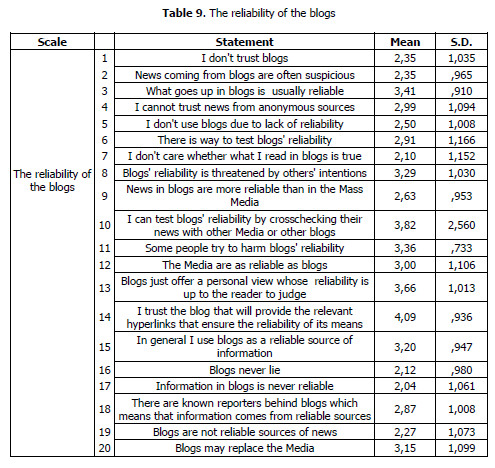
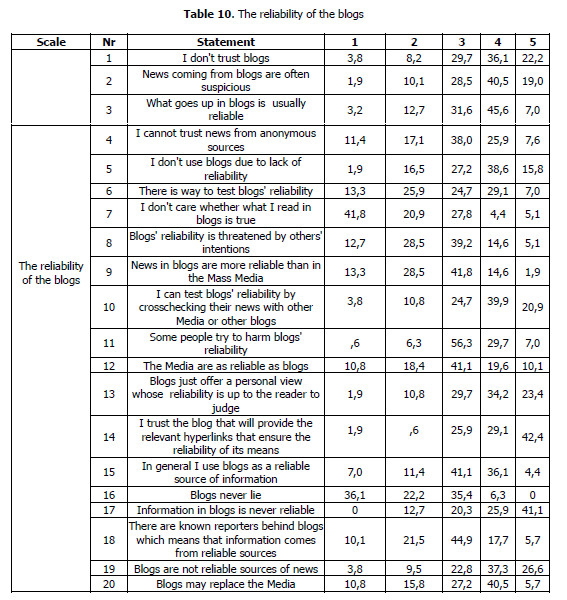
According to the responses in the third subscale, blogs do not present a totally clear picture as to their reliability, although they gather generally positive answers as to this parameter. The mean of the scale is 3,22 and the responses to statements such as 1, 3, 5, 19 on one hand and to statements such as 15, 11 and 13 demonstrate that the research subjects provide partially discordant positions.

It appears that the social role of blogs is the one that is more popular with the young people. Perhaps it is because young people have already started to realize that the traditional media are not marked either for objectivity or for their ingenuous social role. Especially in Greece, during this time of crisis, it seems that the media have been playing a one-dimensional political and social role by providing all kinds of support to the government policy of the Memorandum of Understanding and by hushing up the socially opposing voices and the social movements (cf. Lygeros, 2013: 26, Pleios, 2013). Despite the fact that the reliability of the blogs as well as their role as sources of information present a lower (although positive) mean in relation to their social role, one could assume that the social role of blogs is the one that creates the positive image to the young people.
Anova analysis showed that, in general, the means of every subscale and the total scale are not affected by the demographic and social qualities of the participants. The only statistically significant differences were detected in the relation between the faculty of attendance (F=7,344, df=2, sig=0,001), the degree of urbanity (F=4,069, df=4, sig=0,008) and the mother's education (F=3,181, df=4, sig=0,015) with the mean score of the third subscale (The reliability of the blogs). The analysis showed that the students of the Department of Applied Informatics are those who mainly highlighted the reliability of blogs (Mean=3,39 and SD= 0,38). The students whose mothers have a higher education demonstrate the highest mean in the 3rd subscale (Mean=3,54 and SD=0,43). Finally, the students who live in rural areas produced the lowest values of concordance in the 3rd subscale (Mean=3,008 and SD=0,34). Apparently those who come from rural areas are the most sceptical towards blogs, something that seems reasonable considering the vast development discrepancies between rural and urban areas in Greece (Maloutas and Kandylis, 2010; Kyridis et. al, 2011; Koutouzis et al. 2012; ?siganou and Zacopoulou, 2004). It is also expected that students' responses are influenced by their mother's education level, since numerous studies have indicated
that the cultural capital of children in Greece is mostly affected by their mother's education level (Kyridis, 2003; Tsatsaroni et al. 2011). It appears that a high maternal education level reduces students' apprehensiveness towards blogs.
Openquestions
THEME 1 "Blogsasasourceofinformation"
1. Future source of information
2. Blogs are a means of information on many, various issues
3. I don't know
4. Blogs are the same source of information as the Mass Media
5. Blogs are an alternative source of information that may replace the Media
Regarding the question if they consider blogs as a source of information, 10,6% think they are the future source of information. Another 19,1% believe that blogs are a means of information on many, various issues, 48,9% doesn't know, 2,1% think that blogs are the same source of information as the Mass Media and 19,1% consider blogs as an alternative source of information that may replace the Media.
THEME 2 "Blogs' reliability"
In the second line of reliability, content analysis was performed on the responses with the following 4 categories of answers:
1. Reliability depends on other factors.
2. Blogs are a reliable source of information
3. I don't know
4. Blogs are not always a reliable source of informatio
In relation to whether they think blogs are reliable, 23% believe that reliability depends on other factors. Another 19,1% consider blogs as a reliable source of information, 37% doesn't know and 20,9% think that blogs are not always a reliable source of information.
Correlational results
At this point we will locate the lowest and the highest degree of accordance of the responses for each one of the three categories of the questionnaire (Category A= Information, Category B= Social Role, Category C= Reliability).
More specifically, for Category A, the highest degree of accordance is found for the question "When I am interested in some news I try to search blogs as well". The lowest degree of accordance is located in the question "I am intimidated by that much information flow in blogs".
As to Category B, the lowest degree of accordance is found for the question "Blogs are mainly created by marginal people" and the highest degree of accordance is located in the questions "Blogs serve the current events" and "Blogs are an increasingly prevalent trend".
Concerning Category C, the lowest degree of accordance is found for the questions "Information in blogs is never reliable" and "I don't care whether what I read in blogs is true". The highest degree of accordance is located in the question "I trust the blog that will provide the relevant hyperlinks that ensure the reliability of its means".
An ANOVA test with one variable followed, so as to draw conclusions regarding how a factor affects a quantitative variable. In this research we used an independent variable: a series of factors both from the demographic data and also the dependent questions of the main part of the questionnaire. When the results appeared, the following factors were found to be of influence:
- the variable "Institution of attendance"
- the variable "Age"
- the variable "Employment"
- the variable "Field of studies"
- the variable "Degree of urbanity"
- the variable "Maternal occupation"
- the variable "Paternal education"
- the variable "Maternal education"
Regarding age, it is indicative that those over 23 appear to be more cautious about blogs, whereas students of 18-22 years old trust blogs more as a source of information and believe that in the future they may replace the Media (F= 14,481, df=1, p<0,01). Both age categories agree that people will express themselves through blogs. It seems reasonable that older students are more apprehensive towards blogs, probably because of their developmental maturity.
Furthermore, concerning the variable about the father's education it appears that those who use blogs as a trustworthy source of information have a father that is a high school graduate and those who agree that blogs may replace the Media come from a father with a university or a Master's degree, but they disagree that information in blogs is never valid (F= 3,482, df=5, p<0,05). The paternal education level influences the students' responses to the above statements, mostly because fathers with a higher education level provide their children with a higher cultural capital (Bourdieu, 1979), a fact that allows them to be more "open" to blogs.
As to the "Maternal education" variable, it seems that blogs are more preferred than television as a source of information by those whose mother has a Master's degree, those who agree that news on blogs are always valid come from a mother that has a university degree (F= 2,851, df=7, p<0,05), those who believe that the blogs' advantage is that they do not belong to big economic or social interest groups are born to a mother that has a Master's degree (F= 2,730, df=7, p<0,01), but they also disagree that the reliability of blogs is threatened by others' intentions (F= 3,934, df=7, p<0,01). Those whose mother comes from any level of education agree with the view that "I can test blogs' reliability by crosschecking their news with other Media", whereas those with a university graduate mother agree that "some people try to harm blogs' reliability" and they "use blogs as a reliable source of information" (F= 2,576, df=7, p<0,05). Those whose mothers come from any level of education disagree with the idea that "the information in blogs is never reliable" and, finally, all students of the sample disagree with the view that "There are known reporters behind blogs which means that information comes from reliable sources", except from those whose mothers have Master's degrees (F= 2,283, df=7, p<0,05). In a proportional manner with the paternal education, the maternal education also influences the responses of the sample. It is obvious that students whose mothers enjoy a higher level of education stand more critically against blogs.
Conclusions
The first field of the research concerned blogs as a means of information. Rowan (2002) reports that one of the most popular usages of new technologies regards the provision of information to the public. As information tends to be one of the most important commodities in today's societies, new technologies allow citizens to have indirect access to any information, anywhere. What arises from the research that we performed is that students in general show a predilection for blogs as a means of communication and information. From the subjects' responses it appears that a considerable percentage of the students agrees with the view that blogs provide information indirectly and often more rapidly than the Mass Media [see the items 3 (mean= 3,59, sd=1,066), 5 (mean=3,28, sd=1,210) 7 (mean=3,11, sd=1,236), 9 (mean= 3,79,sd= 1,100), 12 (mean= 3,63 sd= 0,980) and 16 (mean= 3,27, sd=0,801 of the first subscale].
A significant advantage that blogs share is interactiveness, which to a large extent serves as an element of differentiation in relation to the other Media. In particular, Media like television and the newspapers offer news transmission without, however, any interaction with the public. On the other hand, blogs are the means where the public forms the news – information (Turban et. al, 2010). The research indicated that a significant advantage of blogs over the other Media is their interactiveness. The vast majority of the subjects reported that they appreciated the existence of this interaction since they like commenting on the news and expressing their views [see item 10 (mean= 3,62, sd=1,234) of the first subscale]. This may be the great advantage of blogs in relation to the Media that often transmit information in the way they want. On the contrary, they disagree (72,8 % - item 6 within the 2nd subscale) with the view that blogs are a form of communication of marginal groups, a fact that indicates their importance as a source of information.
The second point of reference in the research is the social role of blogs. It is probably a timely element given the fact that the social changes that recently occurred in countries in North Africa and the Middle East, as well as many social processes in our country focused on blogs.
The research demonstrated that young people ascribe a particularly significant social role to blogs. More specifically, they accept blogs as agents of changes and social processes [see items 7 (mean= 3,97sd=0,960, 17 (mean=3,08, sd=0,826), 18 (mean= 3,34 sd=0,747) and 20 (mean= 3,46sd=0,886) of the second subscale]. Blogs may not replace the rallies and demonstrations that we often see on streets – as recently with the demonstrations in various squares of the country – but this does not mean that they cannot have a distinctly important contribution to social changes. Research is admittedly limited on this issue as blogs as a social phenomenon are something relatively recent. As Karamichas (2007) reports, blogs as agents of changes demonstrated their role relatively recently, but this is something we are experiencing as the lines of this study are being typed.
As to the students' views, it is without a doubt that they acknowledge the value of blogs as means of social influence and formation of social movements. It is characteristic that blogs are reported as potential means of social changes as well as the voice of vulnerable groups. It should be stressed, however, that in many questions a considerable number of students were neutral to the answers; in many cases this number ranged from 30-40% of the sample. This means that there is a substantial number of young people that adopt a wait-and-see attitude, despite a significant part of the sample that agrees with the view that blogs can be a reference point regarding social changes and that in the future assemblies and social dialogue may occur through this channel.
The third field of the research regarded blogs' reliability. In recent years several studies (cf. Johnson et al., 2007; Kaid & Postelnicu, 2007) focus on the (possible) lack of reliability regarding the information published in blogs (Pleios, 2011:324) that is associated with many parameters, such as the articles' anonymity or the information about – usually current – events that take place in the real world (cf. Pleios et al. 2010). In the present research, young people seem to express a trend in considering blogs as reliable [see items 1 (mean=2,35, sd=1,035), 3 (52,6%), 15 (mean= 3,20, sd = 0,947) of the 3rd subscale] but there is also a number of them that disagree [see item 9 (mean= 2,63 sd= 0,953) of the 3rd subscale]. For instance, the majority reports (51,8%) that the validity of the information can be tested by associating it with the same information as it is presented in the Media or by using a hyperlink that associates the information with the primary source. On the other hand, it is believed that blogs may lie and therefore in many cases their views seem to differ according to the question and the content of the answer. Either way, we observed a general cautiousness regarding reliability and this cautiousness has been illustrated by the total mean of the 3rd subscale. Finally, it should be noted that a percentage of the students believe that blogs will soon replace the Media and increase their reliability in the future.
As an overall finding, it seems that there is a positive attitude on behalf of those asked about blogs and this is particularly positive in those that come from urban areas, study computers and whose parents hold a university degree. It is suggested that a future research use a larger sample with the participation of not only students but also young people from other social groups as well.
The research at hand revealed the students' views regarding blogs as media of information, as to their reliability and their social role, and in general pointed out their positive attitude towards blogs.
The fact that blogs provide information and entertainment, whereas at the same time they act as a vehicle for communication and update (Griffith & Papacharissi, 2010), combined with the fact that they can be considered as an easy-to-use communication medium that may create a platform of dialogue between bloggers and readers, leads to the formation of a solid basis of common experience and mutual relations (Chang & Yang, 2012: 2). Relations that are of essence and may affect the to-date balance of power in the communication field of digital data and thus converge more rapidly to what Papathanasopoulos (2011: 417-18) predicted: that in the future multimedia communication field, the social networking media and the "interactive consumers" are expected to prevail. These consumers that blog till they drop or tweet and facebook and have evolved into the most powerful force in today's digital communication media. But these social networking media, too, that rapidly emerge as the new mass communication media, overcoming the "traditional" media such as television in dynamics and consumption time.
The results illustrate a generally positive attitude against blogs. The mean values for the total scale and the subscales as well are positive (>3,0). It should be noted that blogs are viewed favourably by the sample especially in the field of their social value and effectiveness. The Arab spring, the major rallies against the crisis in the European South (Greece, Spain, Portugal, etc) gave prominence to the social media and the blogs in particular as basic sources of information, journalism and communication. It should be stressed that the general acceptance of blogs, as well as the mean values (>3,0) on the three subscales, could mostly be interpreted by the age and the cognitive/social context of development in the population of the research. Besides, the basic users and readers of blogs belong to the young age spectrum (Nielsen, 2011). Another characteristic that should be highlighted is that the media address a target group that is clearly older than the sample population. Therefore, the media thematic, as demonstrated by Lloyd et al., w.y) is in many cases different from that of the classical media, setting diverse promotion priorities that appear more attractive with certain, mostly young ages (Walsten, w.y.; Westerman et al. 2013).
The general scepticism regarding the classic Media highlighted both the blogs as a source of collective information and the social media as peer to peer information. It is a trait of the young people to always look for and find new channels of communication and information. However, despite the fact that the attitudes in the three subscales and the total scale are positive, the least positive ones are those regarding the reliability scale. This is generally expected, although we expected to find a lower reliability score, since blogs were not widespread in Greece up until recently (references show that in the light of 2009, there were 39,374 blogs written in the Greek language and today 32 blogs are being created daily (cf. Zafiropoulos, Vrana, Vagianos, 2012: 399) and every novelty is dealt with negativity in general or at least with suspicion. It is our belief that the unreliability or the doubtful reliability presented by the classic Media in Greece during the crisis period lead significant part of the population to other channels of information (cf. Standard Eurobarometer 76, 2012; Lygeros, 2013: 26).
The fact that the answers of the sample are not generally different according to its demographic and social characteristics shows a joint attitude regarding blogs. In this sense, it appears that the attitudes towards blogs in this specific part of the population are undivided. Unfortunately there is no relevant research in the Greek population and consequently the results cannot be compared with similar, relevant or less relevant studies. However, the cognitive and metacognitive development of the student population and their critical abilities yield greater significance to our findings, since blogs are positively assessed by the young, highly qualified generation that exhibits unprecedented levels of communication and information literacy as well. It should be noted once again that the results of the current analysis cannot be projected to a more general population.
References
Baxter-Magolda, M.B. (2004). Evolution of a constructivist conceptualization of epistemological reflection. Educational Psychologist, 39 (1), 31-42. [ Links ]
Baxter Magolda, M.B. (2006). Intellectual development in the college years. Change, 38, 50-54. [ Links ]
Berge, Z., & Collins, M. (1995). Computer-mediated communication and the online classroom in distance learning. Computer-Mediated Communication Magazine, 2(4), 6. Available at http://sunsite.unc.edu/cmc/mag/1995/apr/berge.html (9/9/2012). [ Links ]
Bourdieu, P. (1979). The Inheritors: French Students and Their Relations to Culture. Chicago: University of Chicago Press. [ Links ]
Chang, Y-S. & Yang, C. (2012). Why do we blog? From the perspectives of technology acceptance and media choice factors. Behaviour & Information Technology. DOI:10.1080/0144929X.2012.656326. [ Links ]
Cottle, S. (2011). Arab Uprisings, media inscriptions. Re-public (05-12-2011). Available at http://www.re-public.gr/?p=4292 (27/12/2012). [ Links ]
de Moor, A., & Efimova, L. (2004). An argumentation analysis of weblog conversations. Proceedings of the 9th International Working Conference on the Language-Action Perspective on Communication Modelling (LAP 2004), New Brunswick, NJ, 2-3 June 2004. Available at https://doc.telin.nl/dsweb/Get/Document-41656/lap2004_demoor_efimova.pdf (9/9/2012).
Flowers, L.A., Osterlind, S.J., Pascarella, E.T., & Pierson, C.T. (2001). How much do students learn in college? Cross-sectional estimates using the College BASE. Journal of Higher Education, 72, 565-583. [ Links ]
Frangokikolopoulos, Ch. A., Chapsos, I. (2012). Explaining the role and the impact of the social media in the Arab Spring. GMJ:Mediterranean Edition. 8(1), 10-20. Available at https://www.academia.edu/2370755/Explaining_the_role_and_impact_of_social_media_in_the_Arab_Spring (21/12/2013). [ Links ]
Ghannam, J. (2011). Social Media in the Arab World. Leading up the Uprisings of 2011. A report to the Center for International Media Assistance. Center for international media assistance. Available at http://cima.ned.org/sites/default/files/CIMA-Social_Media_in_the_Arab_World-Highlights.pdf (02/01/2013). [ Links ]
Griffith, M., & Papacharissi, Z. (2010). Looking for you: An analysis of video blogs. First Monday. 15(1). Available in http://firstmonday.org/htbin/cgiwrap/bin/ojs/index.php/fm/article/view/2769/2430 (6/12/2012). [ Links ]
Gumbrecht, ?. (2004). Blogs as Protected Space. Paper presented at WWW 2004 Workshop on the Weblogging , 2004 - psychology.stanford.edu. Available at http://psych.stanford.edu/~mgumbrec/Blogs_as_Protected_Space.pdf (25/12/2012). [ Links ]
Habermas, J. ([1962]1989). The Structural Transformation of the Public Sphere: An Inquiry into a category of Bourgeois Society. Polity, Cambridge. [ Links ]
Hagedorn, L.S., Pascarella, E.T., Edison, M.I., Braxton, J.M., Nora, A., & Terenzini, P.T. (1999). Does institutional context influence the development of critical thinking? A research note. Review of Higher Education, 22, 247-263. [ Links ]
Hewitt, H. (2005). Blog. Understanding the information reformation thats changing your world. Nashville, Tennessee: Thomas Nelson, Inc.
Herring, S. C., Scheidt, L. A., Kouper, I., & Wright, E. (2007). A Longitudinal Content Analysis of Weblogs: 2003-2004. In M. Tremayne (Ed.). Blogging, Citizenship and the Future of Media. London: Routledge, 3-20. Available at http://ella.slis.indiana.edu/~herring/tremayne.pdf (24/12/2012). [ Links ]
Herring, S. C., Kouper, I., Scheidt, L. A., & Wright, E. (2004). Women and children last: The discursive construction of weblogs. In Gurak et al. (eds.) Into the Blogosphere: Rhetoric, community and culture of weblogs. Available at http://blog.lib.umn.edu.blogosphere/women_and_children.html (27/12/2012). [ Links ]
Herring, S. C., Scheidt, L. A., Bonus, S., & Wright, E. (2005). Weblogs as a bridging genre. Information, Technology & People, 18 (2), 142-171. Available at http://www.academia.edu/233577/Weblogs_as_a_Bridging_Genre (24/12/2012). [ Links ]
Johnson, T. J., Kaye, B. K., Bichard, S. L., & Wong, W. J. (2007). Every blog has its day: Politically-interested Internet users perceptions of blog credibility. Journal of Computer-Mediated Communication,13(1) article 6. Available at http://jcmc.indiana.edu/vol13/issue1/johnson.html (24/12/2012). [ Links ]
Kaid, L. K., & Postelnicu, M. (2007). Credibility of political messages on the internet: A comparison of blog sources. In M. Tremayne (Ed.). Blogging, citizenship and the future of media. London: Routledge. [ Links ]
Karamichas, J. (2012). Square Politics. Key characteristics of the indignant mobilizations in Greece. Paper prepared for presentation at the 62nd PSA Annual International Conference, 3-5 April 2012 Belfast. URL: http://pure.qub.ac.uk/portal/en/publications/square-politicskey-characteristics-of-the-indignant-mobilizations-in-greece(a91f98ac-2ba2-4212-9f16-8cc595dfb021).html (22/10/2013). [ Links ]
Kaplan, A. M., & Haenlein, M. (2010). Users of the world, unite! The challenges and opportunities of social media. Business Horizons, 53(1), 59–68. [ Links ]
Kaye, B. (2007). Blog use motivations: An exploratory study. In M. Tremayne (Ed.). Blogging, Citizenship, and the Future of Media. London: Routledge. [ Links ]
Kim, H. (2005). Blogs as the new media on the internet. Review of Communication, 5 (2), 100–108. [ Links ]
King, P. M., Kitchener, K. S. (1994). Developing reflective judgment: understanding and promoting intellectual growth and critical thinking in adolescents and adults. San Francisco: Jossey-Bass. [ Links ]
Kyridis, A., Tsakiridou, H., Zagkos, Ch., Koutouzis, M. & Tziamtzi, Ch. (2011). Educational inequalities and school dropout in Greece. A regional issue. International Journal of Education, 3(2), 1- 15. [ Links ]
Kyridis, A. (2003). Inequalities in Greek education and access to university (1955 – 1985). Athens: Gutenberg. [ Links ]
Lloyd, L., Kaulgud, P. and Skiena, S. (w.y.) Newspapers vs. Blogs: Who Gets the Scoop? Available at http://www.cs.sunysb.edu/~skiena/lydia/blogs.pdf (22/12/2013). [ Links ]
Loughlin, T. W. (1993). Virtual relationships: The solitary world of CMC. Interpersonal Computing and Technology: An Electronic Journal for the 21st Century, 1(1). (LOUGHLIN IPCTV1N1 on LISTSERV@GUVM.GEORGETOWN.EDU). [ Links ]
Lygeros, S. (2013). Corruption and the Press. Journalism. 1(1):24-26. [ Links ]
Koutouzis, ?., Kyridis, ?., Maloutas, M., Papadakis, N. & Syrigos, G. (2012). Zones of Educational Priority. Summary results of the Group for Social Research of the Ministry of Education. Working Papers, 26, ????a: ????. Available at http://www.ekke.gr/publications/wp/wp26.pdf (22/12/2013). [ Links ]
Maloutas T. and Kandylis, G. (2010). Rationalist visions, spontaneous urbanisation and clientelism. The post-war development of the Greek capital and the expectations of C.A. Doxiadis, in M.C. Boyer, A., Hardman, A.A. Kyrtsis (eds) Space and Progress. Ekistics and the global context of post-World War II urbanization and architecture. Springer. [ Links ]
Nielsen (2011). State of the Media: The Social Media Report. Available at http://cn.nielsen.com/documents/Nielsen-Social-Media-Report_FINAL_090911.pdf (22/12/2013). [ Links ]
Papathanasopoulos, S. (2011).Instead of an epilogue: Mass communication in the 21st century. In S. Papathanasopoulos (Ed.). Mass communication in the 21st century. Athens: Kastaniotis, 413-420. [ Links ]
Pascarella, E.T. (1989). The development of critical thinking: Does college make a difference? Journal of College Student Development, 30, 19-26. [ Links ]
Peraya, D. (1994). Formation à distance et communication médiatisée. Rercherches en Communication, 1, 147-164. [ Links ]
Perry,W. G., Jr. (1970). Intellectual and ethical development in the college years: A scheme. Austin, Tex.: Holt, Rinehart and Winston.
Piaget, J. (1970). Structuralism. Basic Books: New York. [ Links ]
Pleios, G. (2011). Information in the blogosphere: New medium - old rationales? In S. Papathanasopoulos (Ed.). Mass communication in the 21st century. Athens: Kastaniotis, 313-335. [ Links ]
Pleios, G., Poulakidakos, S., Kalpaki, K., Manatou, M., Kappas, G., & Papacharalampous, M. (2010). Publicity and prinate life within the Greek blogosphere. International Journal of Electronic Governance, 3(1). Available at http://www2.media.uoa.gr/sociallab/publications/IJEG%200011%20.pdf (24/12/2012). [ Links ]
Pleios, G. (2013). Crisis and the Greek Media. Editors' Newspaper (9/11/2013). Available at http://www.efsyn.gr/?p=146285 (21/12/2013). [ Links ]
Radsch, C. (2011). Blogosphere and Social Media. In E. Laipson (Ed.) Seismic Shift: Understanding Change in the Middle East. Washington, DC: The Henry L. Stimson Center, 68-81.
Rowan, W. (2002). Digital Marketing: Using New Technologies to Get Closer to Your Customers. London: Kogan Page. [ Links ]
Sekeris, P., & Chenavaz, R. (2012). Arab Spring: Social networks and the dynamics of conflicts. Diplomatic periscope (17-06-2012). Available athttp://www.diplomatikoperiskopio.com/index.php?option=com_content&view=article&id=944:2012-06-15-14-54-13&catid=38:2008-05-31-14-19-14&Itemid=64 (03/01/2013). [ Links ]
Standard Eurobarometer 78 (2012). Media use in the European Union. Report. Standard Eurobarometer 78/Autumn 2012-TNS Opinion & Social. Available at http://ec.europa.eu/public_opinion/archives/eb/eb78/eb78_media_en.pdf (22/10/2013).
Tan, D. L. (1995). Do students accomplish what they expect out of college? College Student Journal, 29, 449-454. [ Links ]
Thompson, J. M. (1999). Enhancing cognitive development in college classrooms: A review. Journal of Instructional Psychology, 26(1), 56-63. [ Links ]
Tremayne, M. (2007). Blogging, citizenship and the future of media. London: Routledge. [ Links ]
Tsatsaroni, A., Vretos, J., Kyridis, A., Katsis, A., Linardos, P. (2012). Overcoming School Failure. Policies that Work. Country Background Report: Greece. Paris - Athens: OCDE / Greek Ministry of Education Lifelong Learning and Religious Affairs. Available at http://www.oecd.org/dataoecd/8/1/49528233.pdf (22/12/2013). [ Links ]
?siganou I. and E. Zacopoulou, (2004) Conflict, in D. Charalambis, L. Maratou-Alipranti, A. Hadjiyanni (eds) Recent Social Trends in Greece 1960–2000, Montreal: McGill-Queens University Press, 266-275 [ Links ]
Turban, E., Lee, J. K., Liang, T.-P., & Turban, D. (2010). Electronic Commerce 2010: managerial perspective. Prentice Hall. [ Links ]
Wallsten, K. (w.y). Political Blogs and the Bloggers. Who Blog Them: Is the Political Blogosphere and Echo Chamber? Available at http://www.journalism.wisc.edu/~dshah/blog-club/site/Wallsten.pdf (22/12/2013). [ Links ]
West, E.J. (2004). Perrys legacy: Models of epistemological development. Journal of Adult Development, 11(2), 61-70. [ Links ]
Westerman, D., Spence, P. R. and Van Der Heide, B. (2013). Social Media as Information Source: Recency of Updates and Credibility of Information. Journal of Computer-Mediated Communication, doi: 10.1111/jcc4.12041. [ Links ]
Zafiropoulos, K, Vrana, V, Vagianos, D. (2012). Bloggers Community Characteristics and Influence within Greek Political Blogosphere. Future Internet. 4(2):396-412. Available at http://www.mdpi.com/1999-5903/4/2/396?utm_source=article_link&utm_medium=email&utm_campaign=releaseIssue_futureinternet(22/10/2013). [ Links ]












